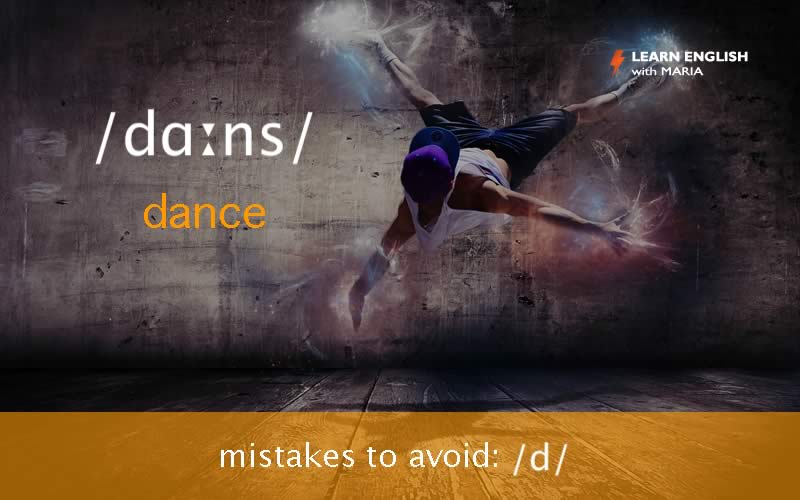Free lesson from Maria’s course: Mistakes to avoid with /d/
[social_warfare]

Below are the five main mistakes you’re likely to be making with the /d/ sound:
Mistakes to avoid with /d/
Mistake 1: Producing an unclear /d/. If you fail to produce a clear /d/, native speakers might have difficulty understanding the word you’re saying.
Notice how native speakers say this word:
/ˈsaɪdə/
To produce a clear /d/, make sure your lips are parted, and the tip of your tongue is pressed against the ridge behind your top front teeth. Then, quickly drop your tongue and let some air out.
Let’s have a look at the lip shape and tongue position for /d/:

Avoid pressing the tip of your tongue against your teeth or your palate. Instead, press it against the ridge behind your top front teeth.
Check your lip shape in a mirror to make sure you’re doing it right. Using a mirror will save you time and effort, and it’ll make a real difference to your pronunciation.
Do you want to practise the /d/? Say these three words out loud. Notice that they all have a clear /d/ sound.
/ˈdɒktə/
/ˈdeməkræt/
/ˌepɪˈdemɪk/
Mistake 2: Making a voiceless sound and producing a /t/ instead of a /d/. Listen to these two words:
The only difference between /ded/ and /det/ is that /d/ is voiced and /t/ is voiceless.
To produce a voiced sound, your vocal cords must vibrate. To make your vocal cords vibrate, the sound must come from your throat. A voiceless sound, on the other hand, comes from the mouth.
Practise saying /d/ and /t/ in succession by first producing sound from your throat, then from your mouth, then from your throat again, and so on. Press Play to hear the native speakers do it, and imitate them:
Now practise saying these three words out loud. Notice that they all have a /d/, which is a voiced sound.
/daʊn/
/hɑ:d/
/dɔ:/
Mistake 3: Dropping the /d/ at the end of words. Here’s a word you may be mispronouncing:
/lænd/
If you drop the final /d/ in “land”, native speakers will have difficulty understanding the word you’re saying.
In other cases the word you’re saying could be mistaken for a different word. Here’s an example:
Do you want to practise the /d/? Say these three words out loud. Notice that they all have a final /d/ sound.
/əˈpɪəd/
/fʌnd/
/bænd/
Mistake 4: Producing two /d/ sounds in succession when saying words spelt with DD. Here’s a word you may be mispronouncing:
/əˈdɪʃᵊnᵊl/
If you say two /d/ sounds instead of one, native speakers will have difficulty understanding the word you’re saying.
Listen to these three words. Notice how they have a single /d/ sound when said by a native speaker:
/ˈdædi/
/ˈpʊdɪŋ/
/ˈtʃedə/
Do you want to practise the DD? Say these three words out loud. Notice that they all have a single /d/ sound.
/ˈhɪdᵊn/
/sʌdᵊnli/
/ˈmɪdᵊl/
Mistake 5: Making a silent D non-silent. If you give a /d/ sound to a silent D, native speakers might have difficulty understanding the word you’re saying.
Notice how native speakers say this word:
/ˈwenzdeɪ/
Now practise saying these two words. Notice that they both have a silent D.
/ˈhæŋkətʃi:f/
/ˈɡrænˌmʌðə/
How to master the /d/ sound
To master the /d/, come back to this section several times over the next few days and weeks. That will help you avoid those mistakes.
To master the /d/ even faster, go through this page one more time now. Click here to flip all the flashcards and reread the mistakes.
Here’s a tip: when I was working on my English accent, I noticed that some of those mistakes were easier to avoid than others. To make fast progress, I first focused on the mistakes that I personally found easier to correct – instead of tormenting myself with the difficult ones.
That gave me a better understanding of the English pronunciation as a whole, and more confidence in my accent. Then I was able to concentrate on the mistakes that I found more difficult, and quickly improved my accent.
Would you like to practise the /d/ with me?
In my Live English Classes I show you step by step how to avoid making the mistakes I’ve listed on this page. Plus, you get to do pronunciation exercises with me using other everyday words.
To get extra practice with the /d/, join my Live English Classes.
What’s next?
In the next section I bring you some words with an unexpected /d/.
Join Maria’s English Pronunciation Course
& get all the lessons